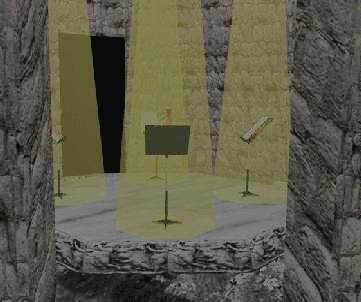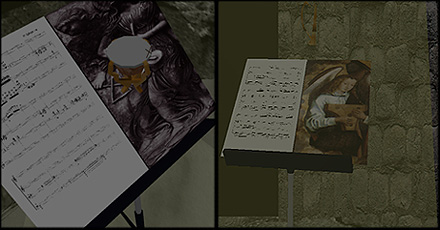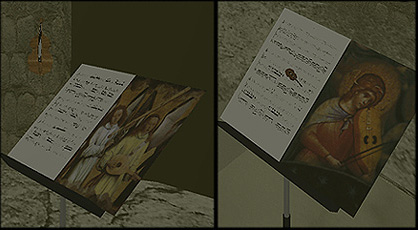
- the MUSIC room -



Music has often been seen as a universal medium, where expression of emotion
and feeling dominate. Themes and ideas of passion, struggle, exhiliration and
wonder flow through the harmonies and rhythms of every note and measure. Climactic
swirls are propogated and then dismissed as quickly and fervently as they appeared.
Music, with all these properties truly encompasses the soul of man's existence.
The music room emulates these notions of ethereal proportions and invites the user to experience them first hand through the interactive playing of instruments. Upon entering the circular room, the user is greeted by sounds from Wagner's "The Ring". A circular "stage" stands in the center of the environment, begging for the user's attention and inviting them to take "center stage".
The room encapsulated in stone and marble presents itself as a place that would unlikely harbor such beautiful sounds. Within this contrast, does true understanding of the environment take place.
The small stage supports music stands which have no seats or instruments associated with them. This is however untrue. At second glance (and with closer inspection), there are icon-like instruments hovering above each music stand. These smaller undetailed objects are placeholders/icons which when activated disappear and allow a full sized, highly detailed/rendered instrument to appear for which the user can play. Triggering the "life-size" versions are done by entering the "sensor" spotlights focused on each stand.

As the user plays the instrument, the sheet music on the stand begins to change. Different images loop that represent how music was treated throughout the ages by different artists. Continuing the movement of playing, sounds eminate which focus on the segment in "The Ring" which isolates that particular instrument.

A new twist that we wished to present in this room in terms of interactivity would've been the ability of the user to use both hands in controlling the instruments. The instruments were chosen because of this ability and necessity to use both hands in playing. This feature may be implemented in a later, more interactive version of the work.
sources: 21, 22
